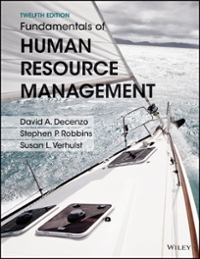Kindness House Hospice is a 30bed facility that provides care for patients nearing the end of their
Question:
Kindness House Hospice is a 30‐bed facility that provides care for patients nearing the end of their life. Recent surveys of patient family members have indicated that perception of the quality of care at Kindness House is declining, prompting the board of directors to ask the medical staff to re‐evaluate procedures and training. Director of Nursing, Kenya Meisner, reported to the board that the medical staff was performing to the best of their ability, but several factors were preventing the quality of care from meeting the board’s high expectations. “Stress,” declared Kenya. “Stress, pure and simple. Hospice care requires different skills than other types of nursing. Our patients won’t recover. They and their families need compassion. New nurses and nurse aids need training in how to provide the right type of care and support, but because of our staffing problems, we just throw them right into patient care. It’s difficult work and without proper training they don’t know how to handle the stress and leave. We’re chronically understaffed and patient care suffers when we have a revolving door of medical staff. Last week we had a nurses’ aid that quit on her first day. She just walked out during her lunch break and sent us a text that she couldn’t handle it and wasn’t coming back.”
Kim Larson, HR Director, backed up Meisner’s assessment adding that “turnover for hospice workers averages 25–30 percent a year. Ours is nearly 60 percent.” Kim added that “The disruptions in care due to turnover reduce the quality of care and cause even more stress.” She went to explain that constantly recruiting, hiring, orienting, and training new medical staff was expensive and time consuming for her and the HR assistant. Little time remained to train the new staff.
When the directors quizzed Larson why the supervisors weren’t assisting in the new employee training process, Meisner and Larson revealed that the supervisor position had high turnover as well and the inexperienced supervisors weren’t always capable of handling their paperwork and personnel supervision duties adequately, so they hadn’t received training in how to participate in the training of new employees.
Larson explained that she and Meisner felt that a more effective onboarding process might help. “If we could hire some temps to ease the staffing problem, we could do a proper orientation and training for our new and recent hires so they understand the role of Kindness House and have the skills to handle the stress. Studies show that if we can improve the overall culture through better onboarding, we can significantly reduce turnover.”
Chris Liang, the CEO exclaimed that it was a great idea. “The CEO of Central Pediatrics Group just developed an onboarding program for their medical staff and I’m sure we can just use their materials. Of course we would change the name to Kindness House. I’ll call him right after our meeting and have his HR Director send their materials to Kim.
Questions:
1. How should Kim Larson handle the suggestion to use the onboarding program from Central Pediatrics? What onboarding, socialization, and orientation practices would be appropriate for new medical staff at Kindness House?
2. Using the ADDIE model of training design, design an employee development program for the supervisors.
3. Identify the best training methods for teaching the medical staff at Kindness House how to relate to patients, how to handle stress, correct completion of paperwork, and proper safety procedures. Explain why you selected each training method.
4. Research: Find examples of how improved onboarding and training been used to improve culture, reduce turnover, and increase efficiency in healthcare or other industries. Summarize your results and include your sources.
Step by Step Answer:

Fundamentals Of Human Resource Management
ISBN: 9781119032748
12th Edition
Authors: David A DeCenzo, Stephen P Robbins, Susan L Verhulst





